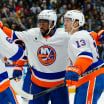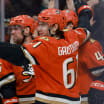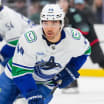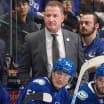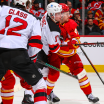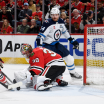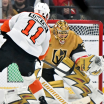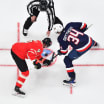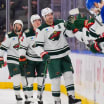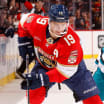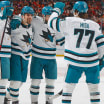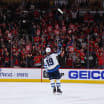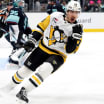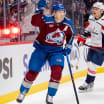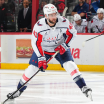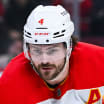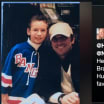VOORHEES, N.J. -- Philadelphia Flyers development coaches John Riley and Kjell Samuelsson always are looking for new ways to help future Flyers reach their full potential.
This year that quest took them the Phoenix suburb of Surprise, Ariz., spring training home of the World Series champion Kansas City Royals.
Flyers, Royals compare notes
Philadelphia coaches, Kansas City assistant GM discuss teaching, coaching methods in hockey, baseball
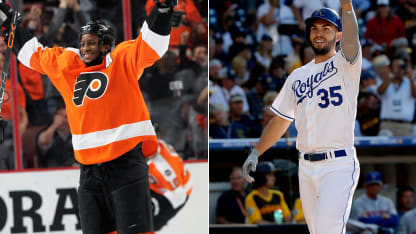
"I try to be open-minded and be progressive with my learning," Riley said. "Certainly watch other sports and learn from them."
The arrangement came together after Royals assistant general manager of player personnel J.J. Picollo spoke to Flyers general manager Ron Hextall. Picollo grew up a Flyers fan in the Philadelphia suburb of Cherry Hill, N.J.
"Every spring training I look at the [Arizona] Coyotes schedule to see if the Flyers are in town, so this year the Flyers were in town during spring training," Picollo said. "… I said, 'I'm going to try to get in touch with Ron Hextall and just offer our gym, our facility.' I don't know what their routines are on the road, but if they needed a place to work out if they wanted, they're more than welcome to come use our place.
"And I wanted to see if I could sit down with them and talk about development philosophies. There's a lot of similarities between the two sports, and it's always interesting to hear from somebody from another sport."
Hextall had taken part in similar brainstorming sessions with the Los Angeles Dodgers when he worked for the Los Angeles Kings, so he accepted Picollo's invitation and sent Riley and Samuelsson to spend time with Picollo and his staff.
Most of the discussions centered on the development paths players take to reach the top level of their sport. Baseball has a minor-league system in which players spend a few years climbing to reach the major leagues. In hockey, players can jump directly from the NHL Draft to the League at 18.
"It was more philosophical, more organizational," Riley said. "'What do you guys do? What's your process? How do you take a player from A to B?' And have an opportunity to go behind the scenes and watch that, and talk about development of baseball players vis-à-vis the development of hockey players."
Riley said one of the things he noticed was the Royals' emphasis on basic baseball fundamentals.
"The first morning we were there, we watched 40 professional baseball players work on rounding first base for 20 minutes," he said. "And then all of the little drills they do in spring training and how that can translate to teaching fundamentals in hockey. You want to make sure in the development process, you don't overlook those things."
Riley said there weren't specific baseball drills he was able to convert to hockey, but said there are some similar skills at work in the two sports.
"Kjell and John spent time with our outfield coach [Rusty Kuntz], because I thought that was our most parallel movements to hockey, the way an outfielder may open up to get a fly ball," Picollo said. "And he does our baserunning too. The way a baserunner may cross over and try to steal a base, I thought the drill work there would be most similar to hockey movements.
"And then there's swing skills, too. There's obviously differences between shooting a puck and swinging at a baseball, but there are some similarities in hips and strength and leverage. So just kind of watching. John and Kjell watched different drills and talked to some of our coaches and asked a lot of questions."
Picollo had his own questions, a number of which involved how the Flyers integrated so many multinational players into an on-ice setting.
"We have kids from Italy now, but it's mostly Latin America," Picollo said. "How do they integrate Russians? How do they integrate guys from the Netherlands? … It's the communication. How do you communicate on the ice, moving, when you guys aren't speaking the same language?"
They also exchanged ways of incorporating analytics into the development process.
"We got into the sport science part of it too," Picollo said. "How are we analyzing data? How are we analyzing our analytics department? We talked about how we've integrated analytics. The sport science is still something we're a little short on. We've started to use heart monitors, things of that nature. But they were using them, key stages to measure stride length on players in practice. Basically gives you an indicator of when a player is shortening or lengthening their stride because they're tired, and it should be around the 45-second mark, at the end of a shift, and you can get them off the ice.
"Things like that, where is technology taking it, and how do we combine the sport science with the technology with the basic fundamentals of the game?"
Both sides felt they got a lot out of the time together, and the door remains open for future meetings.
"It turned into a really neat experience," Picollo said. "I know on my part it was, and John and I have continued to keep in touch. I know we will over time. Was a fun thing to do."
